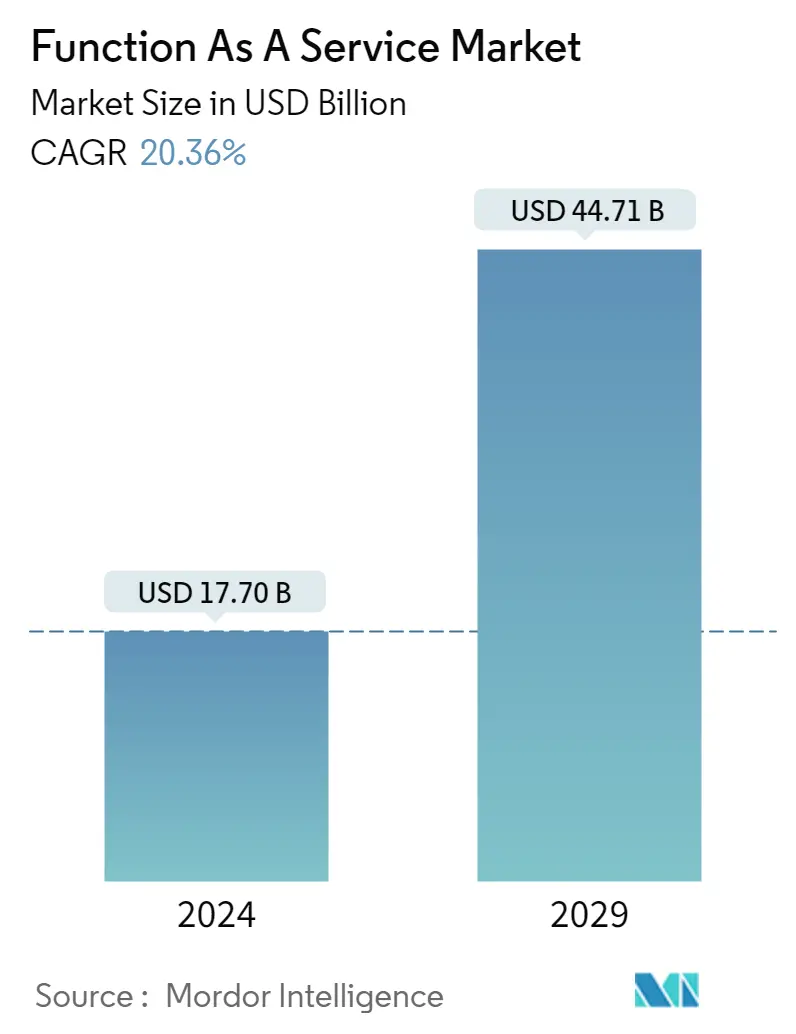Market Size of Function As A Service Industry

| Study Period | 2019 - 2029 |
| Market Size (2024) | USD 17.70 Billion |
| Market Size (2029) | USD 44.71 Billion |
| CAGR (2024 - 2029) | 20.36 % |
| Fastest Growing Market | Asia Pacific |
| Largest Market | North America |
Major Players
*Disclaimer: Major Players sorted in no particular order |
Need a report that reflects how COVID-19 has impacted this market and its growth?
Function as a Service Market Analysis
The Function As A Service Market size is estimated at USD 17.70 billion in 2024, and is expected to reach USD 44.71 billion by 2029, growing at a CAGR of 20.36% during the forecast period (2024-2029).
- Function as a Service (FaaS) is a type of cloud computing that allows developers to operate more efficiently by eliminating the need to manage application infrastructure. When developers use a FaaS platform, the platform builds, runs, and manages application packages on their behalf.
- The growing shift from development operations (DevOps) to serverless computing, agility, scalability, and the maturity of hosted services drive the market's growth. Also, companies' inclination towards optimizing microservices and managing multiple platforms is expected to boost the market's growth.
- With the emergence of FaaS, the programmable cloud has been rapidly growing for the deployment of applications. According to Oracle, it is estimated that there will be 600 times more sensitive data shared in the cloud. Many cloud providers offer FaaS, such as AWS Lambda, Azure Functions, etc. With these models, developers seek advantages in simple deployments, reduced operation efforts, and pay-as-you-go pricing.
- COVID-19 boosted the investments by companies in IT and cloud resources as companies across various industries started realizing the benefits and value of cloud computing, even beyond the immediate need for remote work generated by COVID-19.
- The FaaS offers inherent high availability because it is spread across multiple availability zones per geographic region and can be deployed across any number of areas without incremental costs. With this FaaS, the market will likely grow over the forecast period.
Function as a Service Industry Segmentation
Function as a Service (FaaS) is a central technology in serverless architectures and a type of cloud computing that allows executing code in response to events without the complexity of building and maintaining the infrastructure, which is associated with building and launching microservice applications.
The function as a service market is segmented by type of cloud deployment (public, private, and hybrid), organization size (small and medium enterprises and large enterprises), end-user (BFSI, communication and technology, retail, healthcare and life sciences, and other end users), and geography (North America, Europe, Asia Pacific, Latin America, and Middle East & Africa).
The market sizes and forecasts are provided in terms of value (USD million) for all the above segments.
| By Type of Cloud Deployment | |
| Public | |
| Private | |
| Hybrid |
| By Organization Size | |
| Small and Medium Enterprises | |
| Large Enterprises |
| By End-User | |
| BFSI | |
| IT and Telecommunication | |
| Retail | |
| Healthcare and Life Sciences | |
| Other End-Users (Media and Entertainment, Government, Educational Institutions)) |
| Geography | |
| North America | |
| Europe | |
| Asia-Pacific | |
| Rest of the World |
Function As A Service Market Size Summary
The Function as a Service (FaaS) market is experiencing significant growth, driven by the increasing adoption of serverless computing and the need for enhanced agility and scalability in application development. FaaS platforms, which manage application infrastructure on behalf of developers, are gaining traction as companies seek to optimize microservices and streamline operations across multiple platforms. The shift towards cloud-based solutions has been further accelerated by the COVID-19 pandemic, which highlighted the benefits of cloud computing beyond remote work requirements. The market is also benefiting from the rise of hybrid cloud deployments, which offer organizations the flexibility to scale resources efficiently while addressing data security concerns. This trend is contributing to a broader shift from traditional data center outsourcing to cloud infrastructure-as-a-service models, with hybrid cloud solutions capturing an increasing share of the market.
North America leads the FaaS market, fueled by its role as a pioneer in adopting advanced technologies such as 5G, IoT, and AI. The region's collaboration with hyper-scale cloud providers is enhancing its cloud infrastructure, supporting the development of hybrid and multi-cloud strategies. Key players in the market, including Google, AWS, SAP, IBM, and Microsoft, are actively expanding their offerings through partnerships, acquisitions, and new product launches to strengthen their market positions. Recent collaborations, such as those between Kyndryl and Oracle, and Red Hat Inc. and Accenture, underscore the industry's focus on hybrid cloud innovation. These developments, along with strategic initiatives by companies like Ridge and Tech Mahindra, are driving the market's expansion, as organizations increasingly recognize the value of FaaS in enhancing business agility and performance.
Function As A Service Market Size - Table of Contents
-
1. MARKET DYNAMICS
-
1.1 Market Overview
-
1.2 Market Drivers
-
1.2.1 Growing shift towards serverless computing
-
1.2.2 Increasing focus towards agility of infrastructure and cost reduction
-
-
1.3 Market Restraints
-
1.3.1 Incompatibility of some applications with cloud environment
-
-
1.4 Industry Value Chain Analysis
-
1.5 Industry Attractiveness - Porters Five Forces Analysis
-
1.5.1 Threat of New Entrants
-
1.5.2 Bargaining Power of Buyers/Consumers
-
1.5.3 Bargaining Power of Suppliers
-
1.5.4 Threat of Substitute Products
-
1.5.5 Intensity of Competitive Rivalry
-
-
1.6 Assessment on the Impact of COVID-19 on the market
-
-
2. MARKET SEGMENTATION
-
2.1 By Type of Cloud Deployment
-
2.1.1 Public
-
2.1.2 Private
-
2.1.3 Hybrid
-
-
2.2 By Organization Size
-
2.2.1 Small and Medium Enterprises
-
2.2.2 Large Enterprises
-
-
2.3 By End-User
-
2.3.1 BFSI
-
2.3.2 IT and Telecommunication
-
2.3.3 Retail
-
2.3.4 Healthcare and Life Sciences
-
2.3.5 Other End-Users (Media and Entertainment, Government, Educational Institutions))
-
-
2.4 Geography
-
2.4.1 North America
-
2.4.2 Europe
-
2.4.3 Asia-Pacific
-
2.4.4 Rest of the World
-
-
Function As A Service Market Size FAQs
How big is the Function As A Service Market?
The Function As A Service Market size is expected to reach USD 17.70 billion in 2024 and grow at a CAGR of 20.36% to reach USD 44.71 billion by 2029.
What is the current Function As A Service Market size?
In 2024, the Function As A Service Market size is expected to reach USD 17.70 billion.

